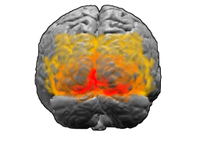
Photo from wikipedia
The natural environment is dynamic and moving objects become constantly occluded, engaging the brain in a challenging completion process to estimate where and when the object might reappear. Although motion… Click to show full abstract
The natural environment is dynamic and moving objects become constantly occluded, engaging the brain in a challenging completion process to estimate where and when the object might reappear. Although motion extrapolation is critical in daily life – imagine crossing the street while an approaching car is occluded by a larger standing vehicle – its neural underpinnings are still not well understood. While the engagement of low-level visual cortex during dynamic occlusion has been postulated, most of the previous group-level fMRI-studies failed to find evidence for an involvement of low-level visual areas during occlusion. In this fMRI-study, we therefore used individually-defined retinotopic maps and multivariate pattern analysis to characterize the neural basis of visible and occluded motion in humans. To this end, participants learned velocity-direction pairings (slow motion-upwards; fast motion-downwards or vice versa) during a training phase without occlusion and judged the stimulus direction, based on its velocity, during a following test phase with occlusion. We find that occluded motion direction can be predicted from the activity patterns during visible motion within low-level visual areas, supporting the notion of a mental representation of motion trajectory in these regions during occlusion. Highlights * Dynamically occluded information is processed in low-level visual cortex * Specific regions inside low-level visual areas encode visible and dynamically occluded information * Overlap of visible and occluded informative activity patterns in the visual field suggest shared computational circuits in primary visual cortex
Journal Title: Human Brain Mapping
Year Published: 2022
Link to full text (if available)
Share on Social Media: Sign Up to like & get
recommendations!